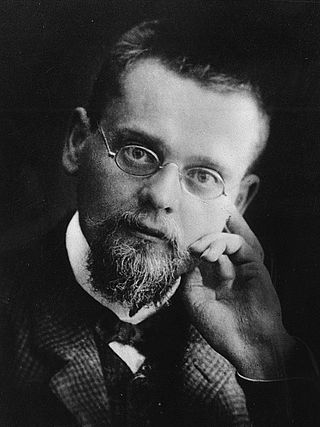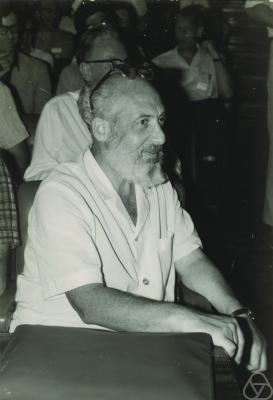Paul Joseph Cohen was an American mathematician. He is best known for his proofs that the continuum hypothesis and the axiom of choice are independent from Zermelo–Fraenkel set theory, for which he was awarded a Fields Medal.

Set theory is the branch of mathematical logic that studies sets, which can be informally described as collections of objects. Although objects of any kind can be collected into a set, set theory — as a branch of mathematics — is mostly concerned with those that are relevant to mathematics as a whole.

Ernst Friedrich Ferdinand Zermelo was a German logician and mathematician, whose work has major implications for the foundations of mathematics. He is known for his role in developing Zermelo–Fraenkel axiomatic set theory and his proof of the well-ordering theorem. Furthermore, his 1929 work on ranking chess players is the first description of a model for pairwise comparison that continues to have a profound impact on various applied fields utilizing this method.
In set theory, a branch of mathematics, a rank-into-rank embedding is a large cardinal property defined by one of the following four axioms given in order of increasing consistency strength.
In mathematics, an Erdős cardinal, also called a partition cardinal is a certain kind of large cardinal number introduced by Paul Erdős and András Hajnal (1958).

Samuel Eilenberg was a Polish-American mathematician who co-founded category theory and homological algebra.
In the mathematical field of set theory, a large cardinal property is a certain kind of property of transfinite cardinal numbers. Cardinals with such properties are, as the name suggests, generally very "large". The proposition that such cardinals exist cannot be proved in the most common axiomatization of set theory, namely ZFC, and such propositions can be viewed as ways of measuring how "much", beyond ZFC, one needs to assume to be able to prove certain desired results. In other words, they can be seen, in Dana Scott's phrase, as quantifying the fact "that if you want more you have to assume more".
In mathematical logic and philosophy, Skolem's paradox is a seeming contradiction that arises from the downward Löwenheim–Skolem theorem. Thoralf Skolem (1922) was the first to discuss the seemingly contradictory aspects of the theorem, and to discover the relativity of set-theoretic notions now known as non-absoluteness. Although it is not an actual antinomy like Russell's paradox, the result is typically called a paradox and was described as a "paradoxical state of affairs" by Skolem.
In set theory, a Rowbottom cardinal, introduced by Rowbottom (1971), is a certain kind of large cardinal number.
In set theory, a Jónsson cardinal is a certain kind of large cardinal number.
In mathematical logic, two theories are equiconsistent if the consistency of one theory implies the consistency of the other theory, and vice versa. In this case, they are, roughly speaking, "as consistent as each other".
In mathematics, Vopěnka's principle is a large cardinal axiom. The intuition behind the axiom is that the set-theoretical universe is so large that in every proper class, some members are similar to others, with this similarity formalized through elementary embeddings.
Azriel Lévy is an Israeli mathematician, logician, and a professor emeritus at the Hebrew University of Jerusalem.
In axiomatic set theory, a mathematical discipline, a morass is an infinite combinatorial structure, used to create "large" structures from a "small" number of "small" approximations. They were invented by Ronald Jensen for his proof that cardinal transfer theorems hold under the axiom of constructibility. A far less complex but equivalent variant known as a simplified morass was introduced by Velleman, and the term morass is now often used to mean these simpler structures.
In set theory, Scott's trick is a method for giving a definition of equivalence classes for equivalence relations on a proper class by referring to levels of the cumulative hierarchy.

Akihiro Kanamori is a Japanese-born American mathematician. He specializes in set theory and is the author of the monograph on large cardinals, The Higher Infinite. He has written several essays on the history of mathematics, especially set theory.

Stevo Todorčević, is a Yugoslavian mathematician specializing in mathematical logic and set theory. He holds a Canada Research Chair in mathematics at the University of Toronto, and a director of research position at the Centre national de la recherche scientifique in Paris.
The Higher Infinite: Large Cardinals in Set Theory from their Beginnings is a monograph in set theory by Akihiro Kanamori, concerning the history and theory of large cardinals, infinite sets characterized by such strong properties that their existence cannot be proven in Zermelo–Fraenkel set theory (ZFC). This book was published in 1994 by Springer-Verlag in their series Perspectives in Mathematical Logic, with a second edition in 2003 in their Springer Monographs in Mathematics series, and a paperback reprint of the second edition in 2009 (ISBN 978-3-540-88866-6).





